(2) DolinSports - Pick Monitor Profile

Posted on October 21st, 2016
MONSTER BRAINS: Herbert E. Crowley (1873 – 1939)
Herbert E. Crowley (1873 – 1939)
 Rye, 1911
Rye, 1911 Five Ghouls, 1911-14
Five Ghouls, 1911-14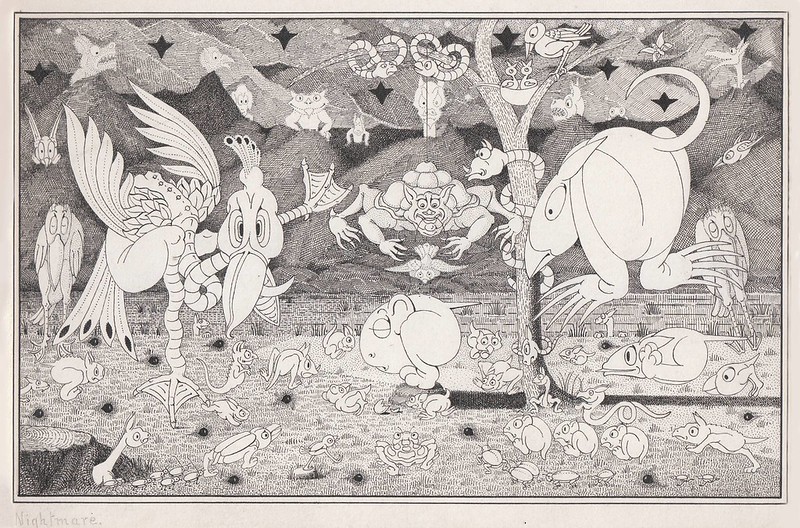 Nightmare
Nightmare Fantastic Animals Left off the Ark, 1911-14
Fantastic Animals Left off the Ark, 1911-14 Slander
Slander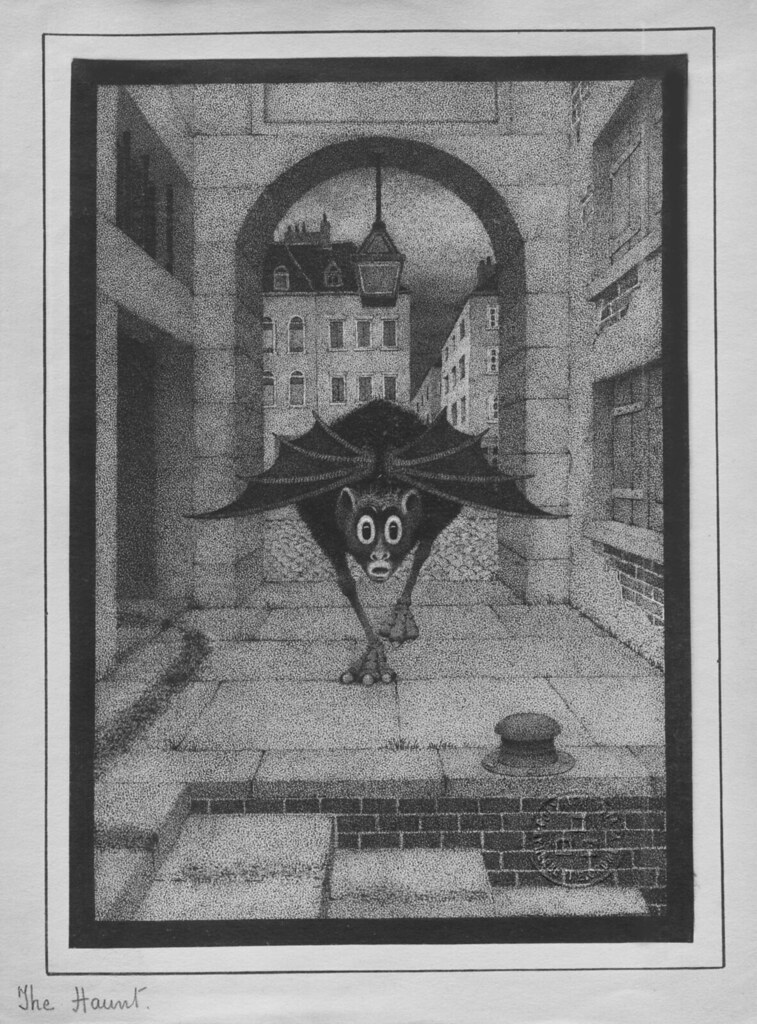 The Haunt, 1920's
The Haunt, 1920's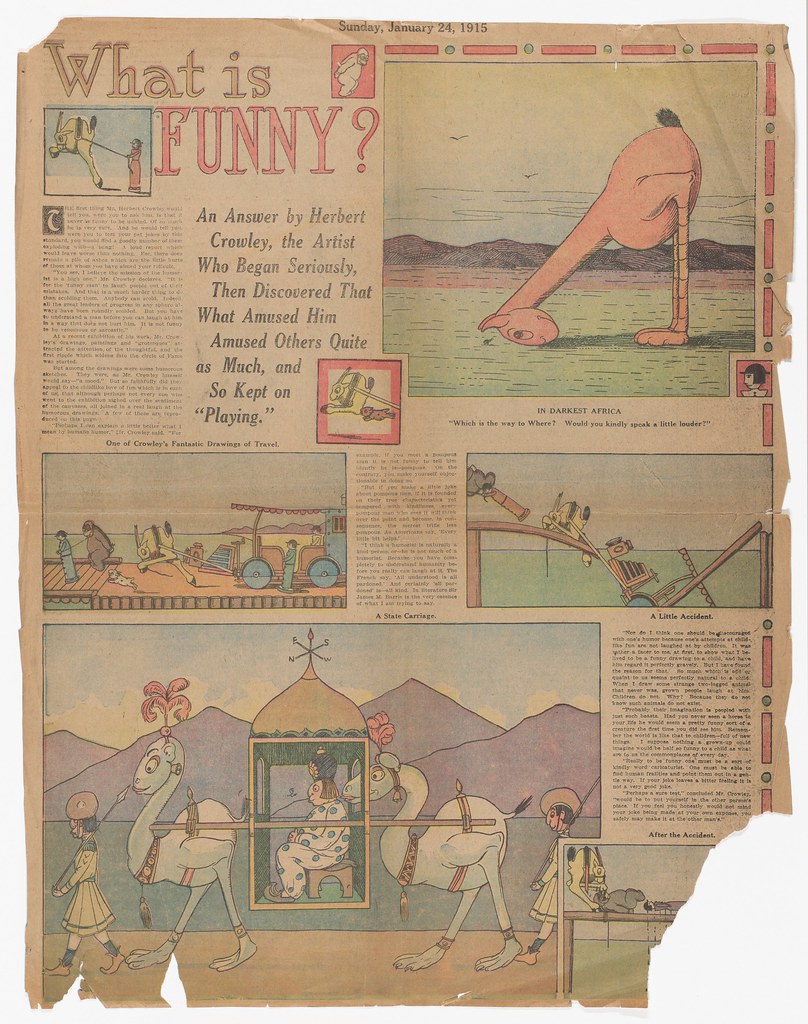 What is Funny? by Herbert Crowley (Toronto Sunday World), January 24, 1915
What is Funny? by Herbert Crowley (Toronto Sunday World), January 24, 1915 "The Wiggle Much" Comic Strip, Number 14 (published by The New York Herald, June 14, 1910)
"The Wiggle Much" Comic Strip, Number 14 (published by The New York Herald, June 14, 1910)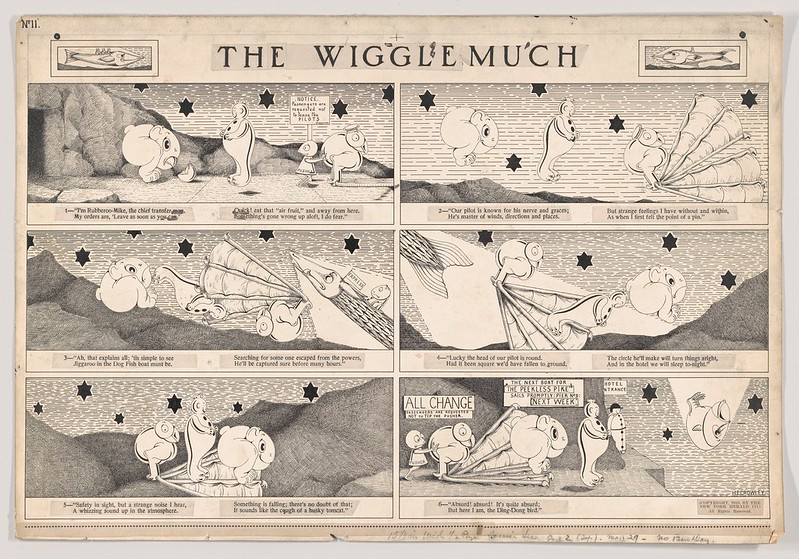 "The Wiggle Much" Comic Strip, Number 11 (published by The New York Herald, May 29, 1910)
"The Wiggle Much" Comic Strip, Number 11 (published by The New York Herald, May 29, 1910)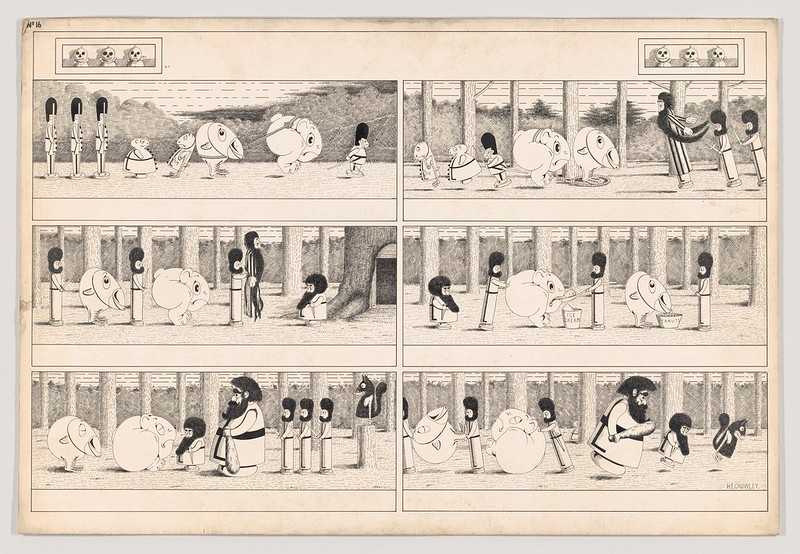 "The Wiggle Much" Comic Strip, Number 16 (not published by The New York Herald) 1910
"The Wiggle Much" Comic Strip, Number 16 (not published by The New York Herald) 1910 "The Wiggle Much" Comic Strip, No. 1 (published in The New York Herald, March 20, 1910)
"The Wiggle Much" Comic Strip, No. 1 (published in The New York Herald, March 20, 1910)"Herbert E. Crowley (1873 – 1939) was a British artist, set designer, and comic strip cartoonist. He is the author of The Wigglemuch, a symbolic comic strip published by the New York Herald. It ran for a total of 13 installments from March to June 1910.
Born in London in 1873, Crowley grew up to become a painter. Even though he studied singing in Paris and became a trained musician, his drawings and cartoons led him to New York, where he lived for around 15 years. His first work after arriving in the US in 1910 was The Wigglemuch (published by the New York Herald), a comic strip that has become his most famous piece. It was also the only collection of comic strip cartoons that he would ever publish. Between 1910 and 1924, many of his paintings and sketches were exhibited in New York, in both collective and individual exhibitions, including the Armory Show in 1913 and frequent artwork displays on 57th Street. He exhibited with Léon Bakst at the Berlin Photographic Company in New York in 1914, where his work was compared to that of William Blake in the exhibition catalog. The New York Times, in an article about the exhibit, remarked, regarding the comparison that "what resemblances may exist between the two artists is strongest in the spiritual quality of their attitude toward their art and a kind of personal symbolism not very clear to the uninitiated."
He married Neighborhood Playhouse founder Alice Lewisohn in 1924, and the two of them became part of the Carl Jung inner circle in Zurich. Crowley was one of the first set designers for the Neighborhood Playhouse, designing sets for The Kairn of Koridwen in 1917. The New York Times mentioned the wedding, held in London in a small item on an obituaries page, identifying Crowley only as "an English artist." The item went on to mention that "... (Alice) told none of her friends of the possibility that she might be married before she returned, but they were not surprised at the news, for she and Mr. Crowley had been close friends for several years."
In the mid-to-late 1920s Crowley returned to London and spent some time traveling. He went to the Middle East and he frequently visited India. Crowley eventually established himself in Zurich, Switzerland, where he would spend the rest of his life. He died in 1939." - quote source
There is currently a kickstarter titled "The Temple of Silence: Forgotten Worlds of Herbert Crowley" with the goal of creating an oversized archival art book of Crowley's work.
A tumblr devoted to the works of Crowley can be viewed here.
Artworks found thanks to Josh O'Neil and at The Metropolitan Museum of Art

Posted on October 21st, 2016
End of Busy: A Deliberate Life vs. Reactive Life, with Jonathan Fields : zen habits

Posted on October 21st, 2016
Who Will Shape the Future of the Data Society? – Open Knowledge International Blog
Who Will Shape the Future of the Data Society?
October 5, 2016, by Jonathan Gray
This piece was originally posted on the blog of the International Open Data Conference 2016, which takes place in Madrid, 6-7th October 2016.
The contemporary world is held together by a vast and overlapping fabric of information systems. These information systems do not only tell us things about the world around us. They also play a central role in organising many different aspects of our lives. They are not only instruments of knowledge, but also engines of change. But what kind of change will they bring?
Contemporary data infrastructures are the result of hundreds of years of work and thought. In charting the development of these infrastructures we can learn about the rise and fall not only of the different methods, technologies and standards implicated in the making of data, but also about the articulation of different kinds of social, political, economic and cultural worlds: different kinds of “data worlds”.
Beyond the rows and columns of data tables, the development of data infrastructures tell tales of the emergence of the world economy and global institutions; different ways of classifying populations; different ways of managing finances and evaluating performance; different programmes to reform and restructure public institutions; and how all kinds of issues and concerns are rendered into quantitative portraits in relation to which progress can be charted – from gender equality to child mortality, biodiversity to broadband access, unemployment to urban ecology.
The transnational network assembled in Madrid for the International Open Data Conference has the opportunity to play a significant role in shaping the future of these data worlds. Many of those present have made huge contributions towards an agenda of opening up datasets and developing capacities to use them. Thanks to these efforts there is now global momentum around open data amongst international organisations, national governments, local administrations and civil society groups – which will have an enduring impact on how data is made public.
Perhaps, around a decade after the first stirrings of interest in what we now know as “open data”, it is time to have a broader conversation around not only the opening up and use of datasets, but also the making of data infrastructures: of what issues are rendered into data and how, and the kinds of dynamics of collective life that these infrastructures give rise to. How might we increase public deliberation around the calibration and direction of these engines of change?
Anyone involved with the creation of official data will be well aware that this is not a trivial proposition. Not least because of the huge amount of effort and expense that can be incurred in everything from developing standards, commissioning IT systems, organising consultation processes and running the social, technical and administrative systems which can be required to create and maintain even the smallest and simplest of datasets. Reshaping data worlds can be slow and painstaking work. But unless we instate processes to ensure alignment between data infrastructures and the concerns of their various publics, we risk sustaining systems which are at best disconnected from and at worst damaging towards those whom they are intended to benefit.
What might such social shaping of data infrastructures look like? Luckily there is no shortage of recent examples – from civil society groups campaigning for changes in existing information systems (such as advocacy around the UK’s company register), to cases of citizen and civil society data leading to changes in official data collection practices, to the emergence of new tools and methods to work with, challenge and articulate alternatives to official data. Official data can also be augmented by “born digital” data derived from a variety of different platforms, sources and devices which can be creatively repurposed in the service of studying and securing progress around different issues.
While there is a great deal of experimentation with data infrastructures “in the wild”, how might institutions learn from these initiatives in order to make public data infrastructures more responsive to their publics? How can we open up new spaces for participation and deliberation around official information systems at the same time as building on the processes and standards which have developed over decades to ensure the quality, integrity and comparability of official data? How might participatory design methods be applied to involve different publics in the making of public data? How might official data be layered with other “born digital” data sources to develop a richer picture around issues that matter? How do we develop the social, technical and methodological capacities required to enable more people to take part not just in using datasets, but also reshaping data worlds?
Addressing these questions will be crucial to the development of a new phase of the open data movement – from the opening up of datasets to the opening up of data infrastructures. Public institutions may find they have not only new users, but new potential contributors and collaborators as the sites where public data is made begin to multiply and extend outside of the public sector – raising new issues and challenges related to the design, governance and political economics of public information systems.
The development of new institutional processes, policies and practices to increase democratic engagement around data infrastructures may be more time consuming than some of the comparatively simpler steps that institutions can take to open up their datasets. But further work in this area is vital to secure progress on a wide range of issues – from tackling tax base erosion to tracking progress towards commitments made at the recent Paris climate negotiations.
As a modest contribution to advancing research and practice around these issues, a new initiative called the Public Data Lab is forming to convene researchers, institutions and civil society groups with an interest in the making of data infrastructures, as well as the development of capacities that are required for more people to not only take part in the data society, but also to more meaningfully participate in shaping its future.
Related
One thought on “Who Will Shape the Future of the Data Society?”
Comments are closed.
About Jonathan Gray
Dr. Jonathan Gray is Prize Fellow at the Institute for Policy Research at the University of Bath. In his role as Director of Policy and Research at Open Knowledge International he has founded and co-founded initiatives such as the Data Journalism Handbook, Europe’s Energy, Open Data for Tax Justice, OpenSpending, Open Trials and Where Does My Money Go?. You can follow him on Twitter at @jwyg and find out more about him at jonathangray.org.
-
This work is licensed under a Creative Commons Attribution 4.0 International License.
-
-
Browse the Open Data Handbook for guides, case studies and resources.
Topics of Interest
beneficial ownershipBrazilChaptersckancommunityCommunity SessioncopyrightData JournalismddjePSIplatformEuropeeventfinancial transparencyGlobal Open Data IndexHackdayhelsinkiindialondonogdcampOGPOKConOKFestivalokfnOpen Access Weekopenbiblioopen budget dataopencorporatesOpen DataOpen Data DayOpen Economicsopen governmentopen government dataOpen Government Partnershipopen heritageOpen KnowledgeOpenSpendingopen spendingopentrialspolicyPublic Domainpublic domain reviewresearchschool of datascienceWhere does my money go?Search
Archives
 OKI Network Planet
OKI Network Planet- Potts’s Discovery of Witches in the County of Lancaster (1845)
- What is the Open Fiscal Data Package?
- What is the Open Fiscal Data Package?
- Paris: uma referência em orçamento participativo 2.0
- Every Society Invents the Failed Utopia it Deserves
- MyData 2016 – What we learned about personal data and where to go from here?
- Tervetuloa uusien aktiivien infoiltaan – Welcome to new actives briefing – Thu 20.10.2016 4 PM
Source code available under the MIT license.
Content on this site, made by Open Knowledge International, is licensed under a Creative Commons Attribution 4.0 International License .
Refer to our attributions page for attributions of other work on the site.

Posted on October 20th, 2016
MyData 2016 – What we learned about personal data and where to go from here? – Open Knowledge International Blog
MyData 2016 – What we learned about personal data and where to go from here?
October 18, 2016, by Mor Rubinstein
This piece is the final installment of a three-part series of posts from MyData 2016 – an international conference that focused on human-centric personal information management. The conference was co-hosted by the Open Knowledge Finland chapter of the Open Knowledge Network. Part 1 looked at what personal data has to do with open data and Part 2 looked at how access to personal data is linked to wider social issues.
The MyData2016 conference came to an end a couple of weeks ago, and we are now even past the International Open Data Conference, but given the discussions that emerged, it is clear this is only the beginning of something bigger. While MyData is still a vague concept, the conference started many processes that might evolve into something tangible. During the conference I met participants that enlightened me about the MyData concept, reminding that conference is more than panels and workshops, but also about the human connection.
![]()
As I described in my first blog post in the series, I was keen to understand what the connection was between MyData and open data. Now, two weeks later and hours of going over the materials, I still have more questions than answers. Open Data is a techno-legal definition of data; MyData is still less clear. The borders between ‘My Data’, private data, and public data are sometimes blurry and undefined, and there is a need for regulation and open debate about these issues. However, the open data world gives inspiration to the MyData world, and MyData conference was an excellent opportunity for the two communities to learn from one another and think ahead.
“The borders between ‘My Data’, private data, and public data are sometimes blurry and undefined, and there is a need for regulation and open debate about these issues.”
What is MyData? One of the terms that were thrown in the air was “The Internet of Me.” At first, this sounds to me a very millennial description (which brings, for me at least, a bad connotation). Lucie Burgess, from The Digital Catapult, shed a different light on the term. This, in her view, means that we put people, not companies or technical terms, at the center of the internet.
To me, it reminded me of Evgeny Morozov’s concept of ‘Internet-centric’ – when we give the term ‘The internet’ life of its own. When we give the internet life, we sometimes forget that humans are creating it actively, and other parts of the net are passive, like the data that we provide to companies just by using their services. We forget that the internet is what it is because of us. The ‘Internet of Me’ puts the ordinary citizen at the heart of that beast we call ”the internet”. It is a decentralized shift, the idea that we can control our data, our information.
Lucie about Internet of me:
![]() Credit: Pouyan Mohseninia
Credit: Pouyan Mohseninia
What does it mean though when it comes to different types of data? Here is an example from one of the main promises in the field of MyData – the health sector. Health data is one of the most delicate data types out there. Having MyData as a way to make data sharing in the health sector safer and more responsible can assist many to unlock the promise of big and small health datasets to make not only services in the field better but also to improve research and human lives.
Health data raise some important questions – Who owns the data in official health registries? What is the line between MyData and public data? The way is still long, but the conference (and the Ultrahack) helped to shape some new thinking about the topic and look for new use cases.
Here is Antti Tuomi-Nikula, from THL, the Finnish Ministry of health and welfare, speaking about the potential of MyData and the answers we still need to answer:
The question of the border between personal and public data is also a concern to governments. In the last decade, many governments at different levels of jurisdiction are going through efforts to improve their services by using data for better policies. However, government personnel, in particular, local government personnel, often do not have the knowledge or capacity to have a better data infrastructure and release public data in an open way. MyData therefore, looks like a dream solution in this case. I was excited to see how the local municipalities in Finland are already examining and learning about this concept, taking into considerations the challenges this brings.
Here is Jarkko Oksala, CIO of the city of Tampere, the second biggest city in Finland speaking about MyData, and what the open Data community should do in the future:
On the one hand, the MyData concept is the ability to allow one to take control of their data, make it open to be used when they want to. When it comes to the open data community, MyData gives us all another opportunity – to learn. Open Data and MyData are frameworks and tools, not the ends. It was good to see how people come to expand their horizons and acquire new tools to achieve some of our other goals.
![]() Ultrahack in action. Credit Salla Thure
Ultrahack in action. Credit Salla Thure
One of the great side events that help to facilitate these learnings was the UltraHack, a three-day hack that tried to make the very vague concept of open data into actual use. Interesting enough, a lot of the hackathon work involved some open data as well. Open Knowledge in Finland is an expert in organizing hackathons, and the vibrant, energetic spirit was there for the whole three days.
These spirits also attracted visitors from Estonia, who crossed the bay and came to learn about hackathons and the different types of data. It was very surprising for me to see that Estonians see Finland as a place to learn from since I assumed that because Estonia is known for its progressive e-gov services, it would similarly excel at creating an open data empire. I guess that the truth is much more complicated than this, and I was very lucky to learn about the situation there. We are also excited to have our first Open Knowledge event in Estonia a couple of weeks ago to discuss setting up a group there. This would not come to life without the meetings we had in Helsinki.
Here is Maarja-Leena Saar speaking about this topic with me:
- The Open Knowledge community indeed came to learn. I met School of Data Fellow Vadym Hudyma from Ukraine, who works with the Engine room about privacy and responsible data. Vadym brought up many important points, like the fact that we should stop looking at the binary of consent of giving personal data, and how we need to remember the people behind the data points we gather.
“We discussed what we want to do with our data and the question of privacy and the willingness too of people to share and to create open data from private data.”
I also met members from Open Knowledge chapters in Japan, Switzerland, Sweden, and Germany. They came to share their experiences but, also to learn about the different opportunities of MyData. For me, it is always good to catch up with chapters and see their point of view on various topics. Here are some useful insights I got from Walter Palmetshofer from OKF DE, who started to think about MyData concept already in 2011. We discussed what we want to do with our data and the question of privacy and the willingness too, of people to share and to create open data from private data.
More of my conversation with Walter here
All in all, I am grateful for the opportunity I had to go and learn at MyData 2016. It gave me a different perspective on my usual work on open data and open government and allowed me to explore the internet for me. This is, I hope, just the beginning, and I would like to see what other members of the network have to say about this topic.
A big thank you to the members of Open Knowledge Finland and in particular Salla Thure, who hosted me so well and helped me to find my way around the conference. Special thanks also to Jo Barratt, Open Knowledge International’s own audio guru for editing my interviews. Watch this space for his audio blog post from the GODAN summit!
Related
Leave a Reply
You must be logged in to post a comment.
-
This work is licensed under a Creative Commons Attribution 4.0 International License.
-
-
Browse the Open Data Handbook for guides, case studies and resources.
Topics of Interest
beneficial ownershipBrazilChaptersckancommunityCommunity SessioncopyrightData JournalismddjePSIplatformEuropeeventfinancial transparencyGlobal Open Data IndexHackdayhelsinkiindialondonogdcampOGPOKConOKFestivalokfnOpen Access Weekopenbiblioopen budget dataopencorporatesOpen DataOpen Data DayOpen Economicsopen governmentopen government dataOpen Government Partnershipopen heritageOpen KnowledgeOpenSpendingopen spendingopentrialspolicyPublic Domainpublic domain reviewresearchschool of datascienceWhere does my money go?Search
Archives
 OKI Network Planet
OKI Network Planet- Potts’s Discovery of Witches in the County of Lancaster (1845)
- What is the Open Fiscal Data Package?
- What is the Open Fiscal Data Package?
- Paris: uma referência em orçamento participativo 2.0
- Every Society Invents the Failed Utopia it Deserves
- MyData 2016 – What we learned about personal data and where to go from here?
- Tervetuloa uusien aktiivien infoiltaan – Welcome to new actives briefing – Thu 20.10.2016 4 PM
Source code available under the MIT license.
Content on this site, made by Open Knowledge International, is licensed under a Creative Commons Attribution 4.0 International License .
Refer to our attributions page for attributions of other work on the site.

Posted on October 20th, 2016
NHL, NHLPA launch program to help players prepare for future
NHL, NHLPA launch program to help players prepare for future

The NHL and NHLPA want players to plan for life after hockey long before they hang up their skates.
Now they have an avenue to do so.
The league and union on Thursday announced a new program intended to help players further their education, network and find out what jobs they may be suited for, such as finance and broadcasting. The goal of the Core Development Program is to connect with players early so the transition to life after hockey is easier.
''It's not just for players late in their careers,'' deputy commissioner Bill Daly said. ''It's going to be focused on players and really raising awareness among even the younger players that the sooner they can start focusing on the longer term, the better off they'll generally be - as much in their careers as after their careers.''
The NFL, NBA and MLB all have resources to help players transition after retirement, and the NHL Alumni has one with the Break Away program. This new endeavor is closer to the NFL and NFLPA's Player Engagement department that focuses on continued education, financial stability and career development.
Retired defenseman Mathieu Schneider, now the NHLPA's special assistant to the executive director, said player feedback as far back as 2013 helped spawn the new program. He said he believes players are generally conscious of the uncertainty of life after hockey and many wanted more assistance.
''It's really to help guys figure out first what they think they're good at, and then second to help them figure out what they really are good at and to give them the tools to be successful at whatever it may be that they're interested in,'' said Schneider, who called the diversity of the union membership the biggest challenge. ''You have a significant number of players that want to (get a college degree), you have a significant number of players that might want to start their own business, that want to be involved with finance, that want to become agents. While they're playing, they have incredible opportunities that other people might not have.''
Some players have taken their own initiative in establishing non-hockey interests during their playing days, such as Boston Bruins captain Zdeno Chara getting his real estate license. Longtime forward Jeff Halpern, now an assistant coach for the American Hockey League's Syracuse Crunch, considers an example such as Chara the best way to sell this program to current players.
''I think it's easy when guys are ending their careers or at the end of their career for people to become interested because they realize that their window is closing,'' said Halpern, part owner of a fried chicken and doughnut shop in the Washington area. Getting through to young players may ''be the hardest obstacle for the league and for the PA. I think most guys, they want to hear about other examples, other things that could be made available to them.''
Washington Capitals defenseman Nate Schmidt is in the process of studying for his real estate exam and working with an adviser at the University of Minnesota. He said he thinks the program could help a lot of players fill their time and ease their minds.
''A lot of guys, I think, are just scared of what happens after they're done playing,'' Schmidt said. ''Even for a guy that has a college degree, I'm kind of nervous for when that day might come.''
Taking away the ''What now?'' nerves is another potential benefit of the program. In other words, a relaxed player is a better player.
''There have been studies done that show that players that are prepared for life after sports, after their careers, actually perform better during their careers,'' Schneider said. ''Maybe it alleviates the anxiety or the some of the pressure that might come normally.''
The voluntary program is independent of Break Away, but Daly didn't rule out collaboration later. More ideas can't hurt, and players are glad to know they have help coming up with future paths.
''You need to be aware of the opportunity that's there,'' Capitals defenseman Karl Alzner said. ''It's nice to learn and be more of a well-rounded person because hockey is just one part of your life and it lasts for a year to 20, if you're lucky, and then you got a whole lot more hopefully to live.''
---
Follow Stephen Whyno on Twitter at http://www.twitter.com/SWhyno

Posted on October 20th, 2016
Fan angered by P.K. Subban's trade from Montreal Canadiens donating $250,000 to P.K.'s Helping Hand Fund
Fan angered by P.K. Subban trade donating $250K to defenseman's charity
MONTREAL -- A man who took out a full-page ad in a Montreal newspaper to express his anger over P.K. Subban's trade from the Montreal Canadiens to Nashville is making a big donation to the popular defenseman's charity.
The Montreal Children's Hospital said Tuesday that Dr. Charles Kowalski and his wife are donating $250,000 to P.K.'s Helping Hand Fund. The couple had originally pledged $50,000 to the foundation.
Kowalski, an emergency-room physician living in Ottawa, Ontario, and until recently a die-hard Canadiens fan, will make the check presentation Wednesday at the hospital's P.K. Subban Atrium.
The Canadiens dealt the flashy Subban to the Nashville Predators this offseason for star defenseman Shea Weber.
In a full-page ad in Thursday's Montreal Gazette, Kowalski thanked Subban for his time in Montreal and said the trade has shaken his belief in the Canadiens.
"Now, I feel anger, disappointment and embarrassment over the treatment of P.K. Subban by team management: the same sentiments that many felt after the Patrick Roy trade," Kowalski said in the ad.
"You are an amazing and influential role model for my children, and I am going to miss not having you as a Montreal Canadien."
Subban was popular in Montreal because of his charitable endeavors that included a pledge to raise $10 million for the Montreal Children's Hospital.
Sponsored Headlines

Posted on October 20th, 2016




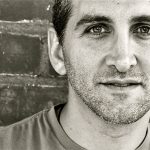 Jonathan: Busyness has become a bit of a lightning rod. In one camp, we’ve got busyness as a status symbol of hustle and achievement (though, often it’s neither). In the other, we have busyness as a signpost of failure and surrender.
Jonathan: Busyness has become a bit of a lightning rod. In one camp, we’ve got busyness as a status symbol of hustle and achievement (though, often it’s neither). In the other, we have busyness as a signpost of failure and surrender.